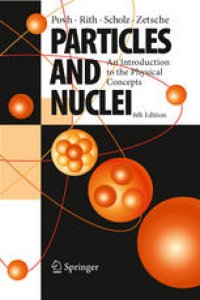
Ebook: Particles and Nuclei: An Introduction to the Physical Concepts
- Tags: Elementary Particles and Nuclei, Quantum Physics, Atoms Molecules Clusters and Plasmas
- Year: 2008
- Publisher: Springer-Verlag Berlin Heidelberg
- Edition: 6
- Language: English
- pdf
This well-established textbook gives a uniform and unique presentation of both nuclear and particle physics. Analysis, Part 1, is devoted to disentangling the substructure of matter. This part shows that experiments designed to uncover the substructures of nuclei and nucleons have a similar conceptual basis, and lead to the present picture of all matter being built out of a small number of elementary building blocks and a small number of fundamental interactions. Synthesis, Part 2, shows how the elementary particles may be combined to build hadrons and nuclei. The fundamental interactions responsible for the forces in all systems become less and less evident in increasingly complex systems. A section on neutrino oscillations and one on nuclear matter at high temperatures bridge the field of "nuclear and particle physics" and "modern astrophysics and cosmology". The new edition incorporates a large amount of new experimental results on deep inelastic scattering (obtained at the Electron-Proton Collider HERA at DESY in Hamburg) into chapters 7 and 8. Translated into many languages, Particles and Nuclei has become a standard reference for advanced and undergraduate courses.
From the reviews of an earlier edition:
"...an excellent introduction to nuclear and particle physics... A very clear presentation... I thus recommend this book as a very good phenomenological approach to the physics of particles and nuclei..." Physicalia
This well-established textbook gives a uniform and unique presentation of both nuclear and particle physics. Analysis, Part 1, is devoted to disentangling the substructure of matter. This part shows that experiments designed to uncover the substructures of nuclei and nucleons have a similar conceptual basis, and lead to the present picture of all matter being built out of a small number of elementary building blocks and a small number of fundamental interactions. Synthesis, Part 2, shows how the elementary particles may be combined to build hadrons and nuclei. The fundamental interactions responsible for the forces in all systems become less and less evident in increasingly complex systems. A section on neutrino oscillations and one on nuclear matter at high temperatures bridge the field of "nuclear and particle physics" and "modern astrophysics and cosmology". The new edition incorporates a large amount of new experimental results on deep inelastic scattering (obtained at the Electron-Proton Collider HERA at DESY in Hamburg) into chapters 7 and 8. Translated into many languages, Particles and Nuclei has become a standard reference for advanced and undergraduate courses.
From the reviews of an earlier edition:
"...an excellent introduction to nuclear and particle physics... A very clear presentation... I thus recommend this book as a very good phenomenological approach to the physics of particles and nuclei..." Physicalia